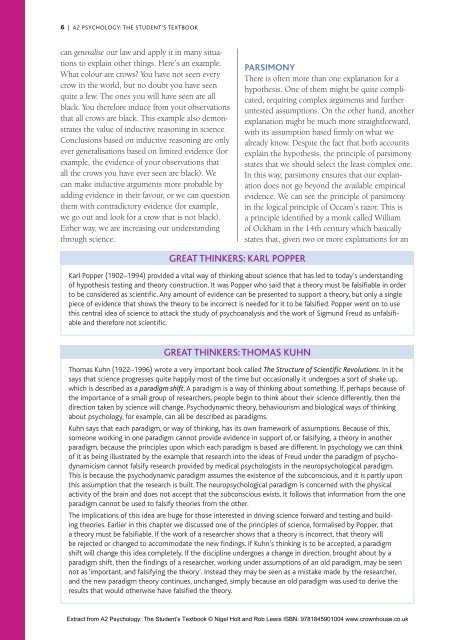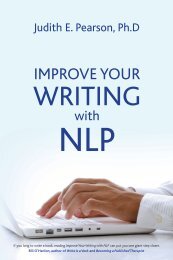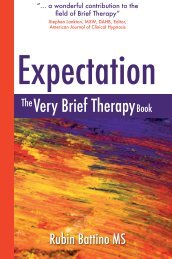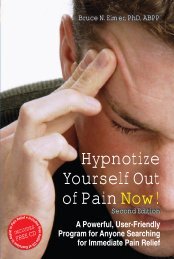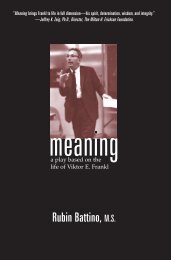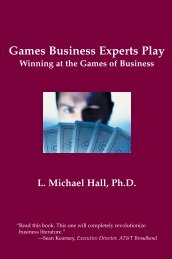Nigel Holt and Rob Lewis - Crown House Publishing.
Nigel Holt and Rob Lewis - Crown House Publishing.
Nigel Holt and Rob Lewis - Crown House Publishing.
You also want an ePaper? Increase the reach of your titles
YUMPU automatically turns print PDFs into web optimized ePapers that Google loves.
6 | A2 PSYCHOLOGY: THE STUDENT’S TEXTBOOKcan generalise our law <strong>and</strong> apply it in many situationsto explain other things. Here’s an example.What colour are crows? You have not seen everycrow in the world, but no doubt you have seenquite a few. The ones you will have seen are allblack. You therefore induce from your observationsthat all crows are black. This example also demonstratesthe value of inductive reasoning in science.Conclusions based on inductive reasoning are onlyever generalisations based on limited evidence (forexample, the evidence of your observations thatall the crows you have ever seen are black). Wecan make inductive arguments more probable byadding evidence in their favour, or we can questionthem with contradictory evidence (for example,we go out <strong>and</strong> look for a crow that is not black).Either way, we are increasing our underst<strong>and</strong>ingthrough science.ParsimonyThere is often more than one explanation for ahypothesis. One of them might be quite complicated,requiring complex arguments <strong>and</strong> furtheruntested assumptions. On the other h<strong>and</strong>, anotherexplanation might be much more straightforward,with its assumption based firmly on what wealready know. Despite the fact that both accountsexplain the hypothesis, the principle of parsimonystates that we should select the least complex one.In this way, parsimony ensures that our explanationdoes not go beyond the available empiricalevidence. We can see the principle of parsimonyin the logical principle of Occam’s razor. This isa principle identified by a monk called Williamof Ockham in the 14th century which basicallystates that, given two or more explanations for anGreat thinkers: Karl PopperKarl Popper (1902–1994) provided a vital way of thinking about science that has led to today’s underst<strong>and</strong>ingof hypothesis testing <strong>and</strong> theory construction. It was Popper who said that a theory must be falsifiable in orderto be considered as scientific. Any amount of evidence can be presented to support a theory, but only a singlepiece of evidence that shows the theory to be incorrect is needed for it to be falsified. Popper went on to usethis central idea of science to attack the study of psychoanalysis <strong>and</strong> the work of Sigmund Freud as unfalsifiable<strong>and</strong> therefore not scientific.Great thinkers: Thomas KuhnThomas Kuhn (1922–1996) wrote a very important book called The Structure of Scientific Revolutions. In it hesays that science progresses quite happily most of the time but occasionally it undergoes a sort of shake up,which is described as a paradigm shift. A paradigm is a way of thinking about something. If, perhaps because ofthe importance of a small group of researchers, people begin to think about their science differently, then thedirection taken by science will change. Psychodynamic theory, behaviourism <strong>and</strong> biological ways of thinkingabout psychology, for example, can all be described as paradigms.Kuhn says that each paradigm, or way of thinking, has its own framework of assumptions. Because of this,someone working in one paradigm cannot provide evidence in support of, or falsifying, a theory in anotherparadigm, because the principles upon which each paradigm is based are different. In psychology we can thinkof it as being illustrated by the example that research into the ideas of Freud under the paradigm of psychodynamicismcannot falsify research provided by medical psychologists in the neuropsychological paradigm.This is because the psychodynamic paradigm assumes the existence of the subconscious, <strong>and</strong> it is partly uponthis assumption that the research is built. The neuropsychological paradigm is concerned with the physicalactivity of the brain <strong>and</strong> does not accept that the subconscious exists. It follows that information from the oneparadigm cannot be used to falsify theories from the other.The implications of this idea are huge for those interested in driving science forward <strong>and</strong> testing <strong>and</strong> buildingtheories. Earlier in this chapter we discussed one of the principles of science, formalised by Popper, thata theory must be falsifiable. If the work of a researcher shows that a theory is incorrect, that theory willbe rejected or changed to accommodate the new findings. If Kuhn’s thinking is to be accepted, a paradigmshift will change this idea completely. If the discipline undergoes a change in direction, brought about by aparadigm shift, then the findings of a researcher, working under assumptions of an old paradigm, may be seennot as ‘important, <strong>and</strong> falsifying the theory’. Instead they may be seen as a mistake made by the researcher,<strong>and</strong> the new paradigm theory continues, unchanged, simply because an old paradigm was used to derive theresults that would otherwise have falsified the theory.Extract from A2 Psychology: The Student’s Textbook © <strong>Nigel</strong> <strong>Holt</strong> <strong>and</strong> <strong>Rob</strong> <strong>Lewis</strong> ISBN: 9781845901004 www.crownhouse.co.uk


